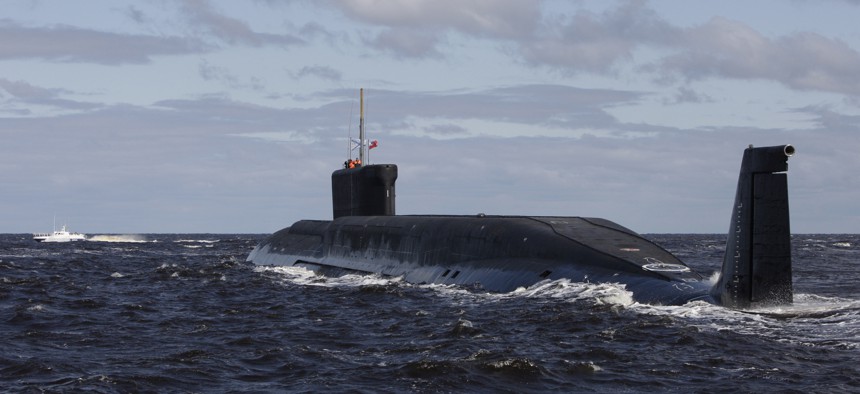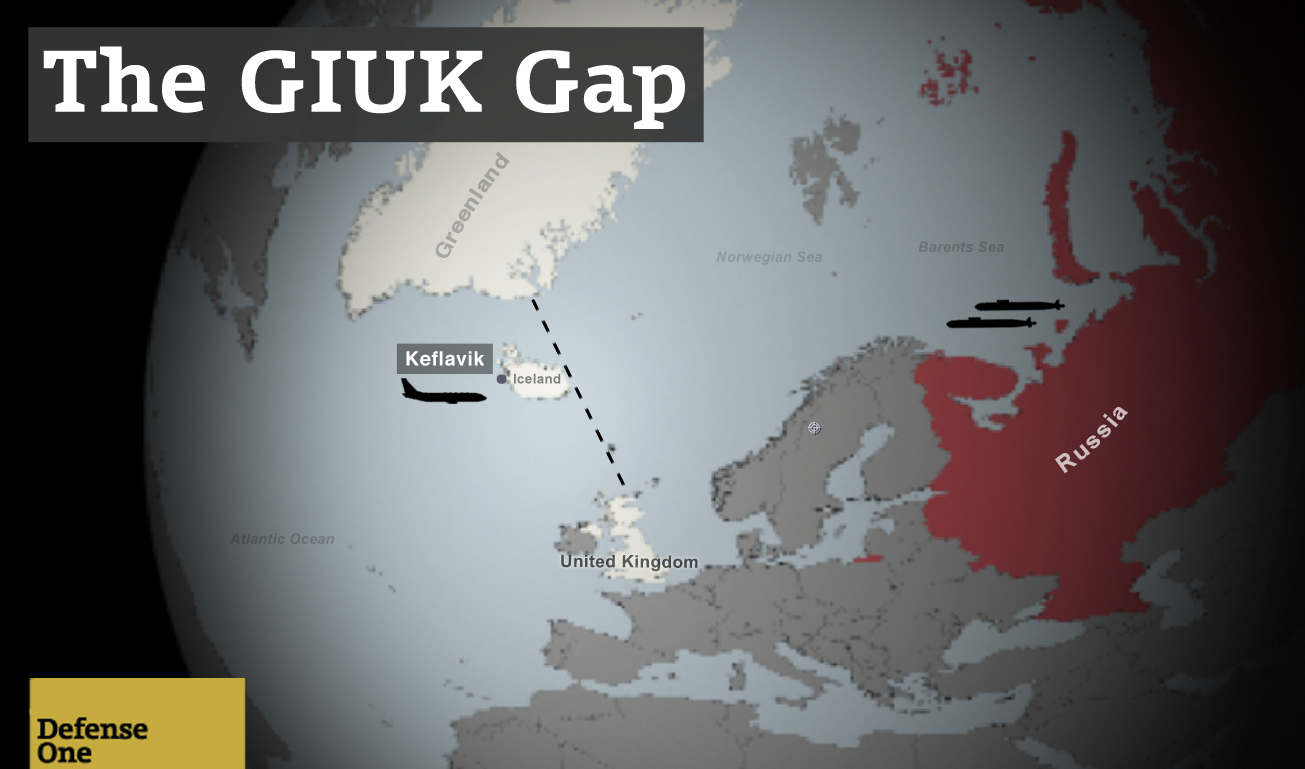
This Thursday July 2, 2009 file photo, shows a new Russian nuclear submarine, Yuri Dolgoruky, near the Sevmash factory in the northern city of Arkhangelsk, Russia. Alexander Zemlianichenko/AP
Russian Subs Are Reheating a Cold War Chokepoint
As the GIUK gap returns to importance, NATO must look to regenerate its anti-submarine forces.
The recent U.S. promise to fund upgrades to Iceland’s military airfield at Keflavik is no diplomatic bone thrown to a small ally. The improvements will allow the U.S. Navy’s new P-8 Poseidon maritime patrol aircraft to keep an eye on Russia’s increasingly active and capable submarine force in a region whose importance is rising with the tensions between Moscow and the West. In short, the Greenland-Iceland-UK gap is back.
During the Cold War, the maritime choke points between Greenland, Iceland, and the UK were key to the defense of Europe. This “GIUK gap” represented the line that Soviet naval forces had to cross in order to reach the Atlantic and stop U.S. forces heading across the sea to reinforce America’s European allies. It was also the area that the Soviet Union’s submarine-based nuclear forces would have to pass as they deployed for their nuclear strike missions. In response, the United States and its northern NATO allies spent considerable time, money, and effort on bolstering anti-submarine warfare capabilities and intelligence, surveillance, and reconnaissance in the region. Maritime patrol aircraft from the UK, Norway, and the U.S. (Navy P-3s, flying from Keflavik) covered the area from above, while nuclear and conventional submarines lurked below the surface. The choke points were also monitored by an advanced network of underwater sensors installed to detect and track Soviet submarines.
But after the Cold War ended, the GIUK gap disappeared from NATO’s maritime mind. U.S. forces left Iceland in 2006, and the UK, facing budget pressures, retired its fleet of maritime patrol aircraft fleet in 2010. (The Netherlands did the same in 2003.) Anti-submarine warfare and the North Atlantic were hardly priorities for an Alliance embroiled in peacekeeping, counter-insurgency, and fighting pirates in far-flung Bosnia, Afghanistan, and the Horn of Africa.

Ben Watson | Defense One
But the term “GIUK gap” is now heard again in NATO circles (and sometimes as GIUK-N gap, to signify the inclusion of the maritime domain around Norway), as it becomes increasingly apparent that Russia is pouring money into its naval forces in general, and its submarine fleet in particular. Moscow is introducing new classes of conventional and nuclear attack submarines, among them the Yasen class and the Kalina class, the latter of which is thought to include air-independent propulsion. AIP, which considerably reduces the noise level of conventional submarines, was until recently seen only in Western navies’ most capable conventional subs. Much of Russia’s investment in its submarine force has been focused on its Northern Fleet, which is based in Murmansk and intended for operations in and around the Arctic, as well as the Atlantic. The Northern Fleet is also the home of Russia’s submarine-based nuclear deterrent.
Russia is believed to be putting these new sub-surface capabilities to the test. The UK, Sweden, and Finland have all launched recent hunts for suspected Russian submarines deep in their territorial waters. Russia has also showed off its new ability to launch land-attack cruise missiles from its submarines; late last year, a sub in the Mediterranean fired Kalibr missiles against targets in Syria.
Russia’s growing sub-surface capabilities are coupled with an apparent political will to use them. Its recently revised maritime strategy emphasizes operations in the Arctic, along with the need for Russian maritime forces to have access to the broader Atlantic Ocean. And that access will have to be, just as during the Cold War, through the GIUK gap.
Now the United States is pivoting back to the region; witness the Obama administration’s recent announcement that it intends to spend part of the proposed 2017 European Reassurance Initiative budget on upgrading facilities at Keflavik.
And the U.S. is not alone. Britain recently announced that it will seek to rebuild its maritime patrol aircraft fleet, probably by buying P-8s from Boeing. Norway is also considering its options for the future of its maritime patrol aircraft, and is also looking to buy a new class of submarines. Norway also recently upgraded its signal intelligence ship with new U.S. sensors, and the ship is primarily intended for operations in the vast maritime spaces of the High North.
The emerging challenge in the North Atlantic should also drive NATO and its members to look hard at regenerating the ability to conduct anti-submarine warfare against a potent adversary. European nations should also take a hard look at its aging maritime patrol aircraft fleet and think about its future. The UK and the Netherlands are not the only countries who let their MPA fleets slip after the end of the Cold War.
While current U.S. and NATO efforts at deterring further Russian aggression may be most visible through ground force deployments, exercises, and pre-positioned equipment in Europe’s east, a mostly unseen contest is also emerging in the North Atlantic. The GIUK gap is back.
NEXT STORY: How NATO Can Disrupt Russia's New Way of War




